【JavaEE进阶】 依赖注?DI详解
文章目录
🌴什么是依赖注入
依赖注?是?个过程,是指IoC容器在创建Bean时,去提供运?时所依赖的资源,?资源指的就是对象.
简单来说,就是把对象取出来放到某个类的属性中.
在?些?章中,依赖注?也被称之为"对象注?",“属性装配”,具体含义需要结合?章的上下?来理解
🎄依赖注入的三种方法
关于依赖注?,Spring也给我们提供了三种?式:
-
属性注?(Field Injection)
-
构造?法注?(Constructor Injection)
-
Setter注?(Setter Injection)
🚩属性注?(Field Injection)
属性注?是使? @Autowired 实现的。
比如我们将StudentService类注?到StudentController类中.
StudentService.java代码如下:
@Service
public class StudentService {
public void run() {
System.out.println("StudentService启动");
}
}
StudentController.java代码如下:
@RestController
public class StudentController {
@Autowired
private StudentService studentService;
public void run() {
System.out.println("StudentController启动");
studentService.run();
}
}
获取StudentController中的run方法
@SpringBootApplication
public class SpringMvcApplication {
public static void main(String[] args) {
//获取spring上下文
ApplicationContext context = SpringApplication.run(SpringMvcApplication.class, args);
//从spring中获取对象
StudentController studentController = context.getBean("studentController",StudentController.class);
//使用spring对象
studentController.run();
}
}
启动项目,结果如下:

🚩构造?法注?
构造?法注?是在类的构造?法中实现注?,如下代码所?:
@RestController
public class StudentController {
private StudentService studentService;
public StudentController() {
}
@Autowired
public StudentController(StudentService studentService) {
this.studentService = studentService;
}
public void run() {
System.out.println("StudentController启动");
studentService.run();
}
}
结果展示:
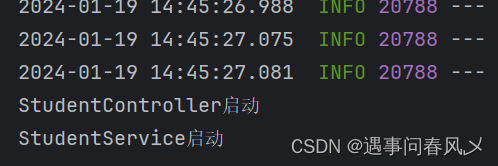
注意事项:
- 如果类只有?个构造?法,那么@Autowired注解可以省略;如果类中有多个构造?法,那么需要添加上@Autowired来明确指定到底使?哪个构造?法
- 如果存在多个构造方法,还没有写注解的话,就会出现以下问题

🚩Setter注?
Setter注?和属性的Setter?法实现类似,只不过在设置set?法的时候需要加上@Autowired注解
@RestController
public class StudentController {
private StudentService studentService;
@Autowired
public void setStudentService(StudentService studentService) {
this.studentService = studentService;
}
public void run() {
System.out.println("StudentController启动");
studentService.run();
}
}
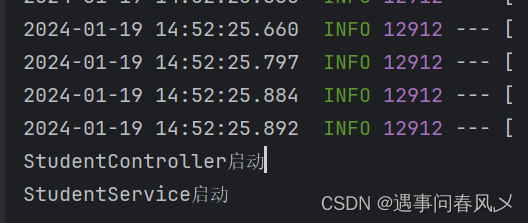
🚩三种注?的优缺点
属性注?:
-
优点:
- 简洁,使??便;
-
缺点:
-
只能?于IoC容器,如果是?IoC容器不可?,并且只有在使?的时候才会出现NPE(空指针异常)
-
不能注??个Final修饰的属性
-
构造函数注?(Spring 4.X推荐):
- 优点:
-
可以注?final修饰的属性
-
注?的对象不会被修改
-
依赖对象在使?前?定会被完全初始化,因为依赖是在类的构造?法中执?的,?构造?法是在类加载阶段就会执?的?法.
-
通?性好,构造?法是JDK?持的,所以更换任何框架,他都是适?的
-
- 缺点:
- 注?多个对象时,代码会?较繁琐
Setter注?(Spring3.X推荐):
-
优点:
- ?便在类实例之后,重新对该对象进?配置或者注?
-
缺点:
-
不能注??个Final修饰的属性
-
注?对象可能会被改变,因为setter?法可能会被多次调?,就有被修改的?险.
-
🌳@Autowired存在的问题
当同?类型存在多个bean时,在使?@Autowired就会存在问题
比如我们有以下bean。
BeanFiguation.java代码如下:
@Configuration
public class BeanFiguation {
@Bean
public Student student1() {
Student student = new Student();
student.setId(11);
student.setName("遇事");
student.setAge(11);
return student;
}
@Bean
public Student student2() {
Student student = new Student();
student.setId(22);
student.setName("问春风乄");
student.setAge(22);
return student;
}
}
StudentController.java代码如下:
@RestController
public class StudentController {
@Autowired
private Student student;
public void run() {
System.out.println(student);
}
}
当我们进行启动时:
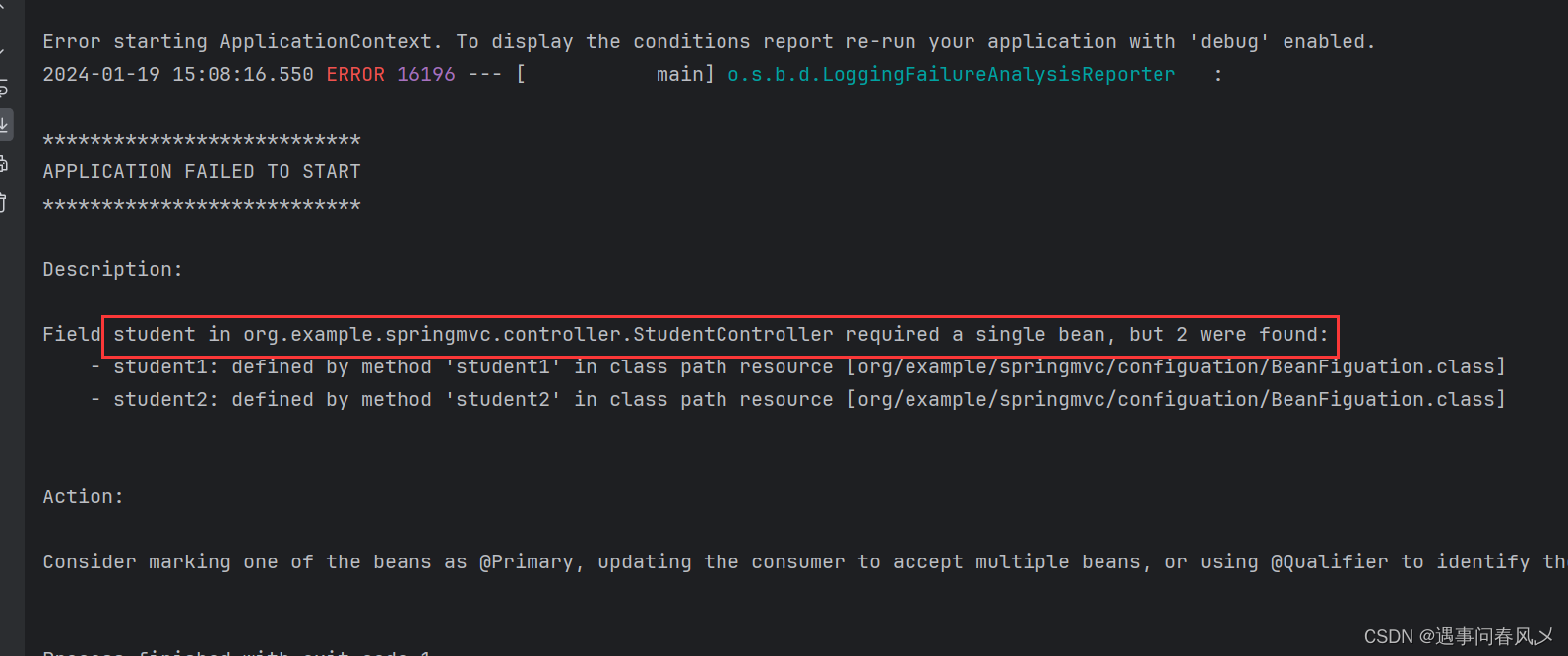
报错的原因是,?唯?的 Bean 对象
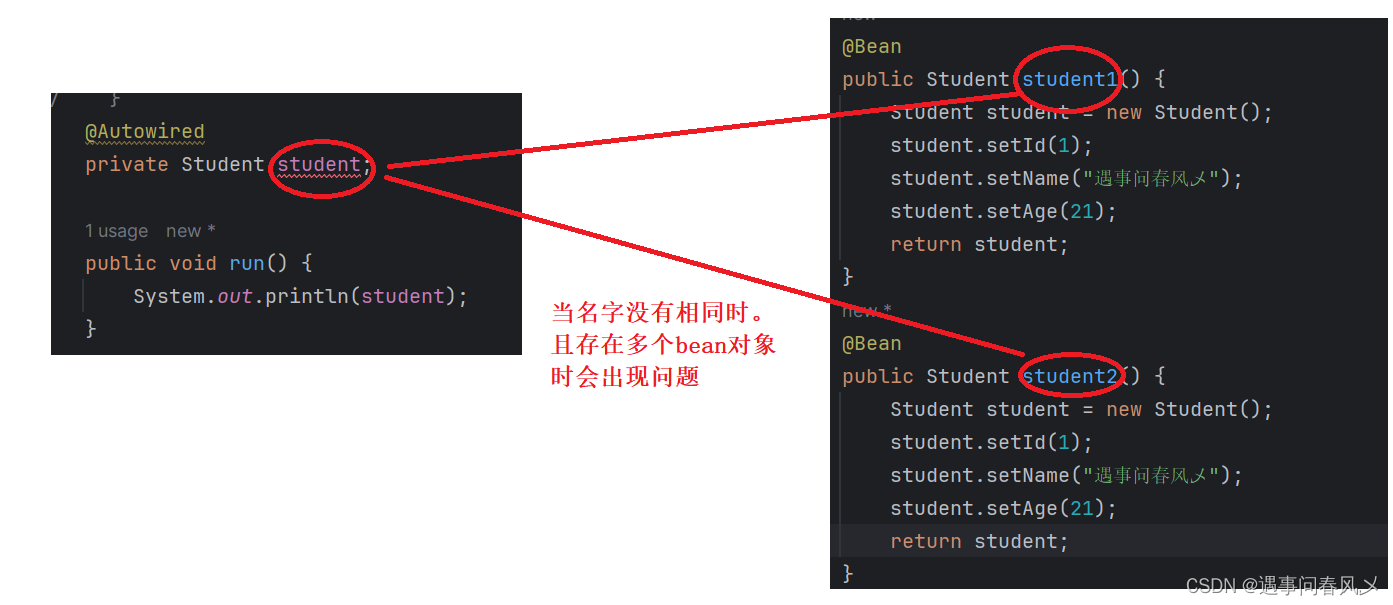
🌲解决@Autowired存在的问题
为了解决上述问题,Spring提供了以下4种解决?案:
- bean对象名称与属性名相匹配
- @Primary
- @Qualifier
- @Resource
第一种:bean对象名称与属性名相匹配
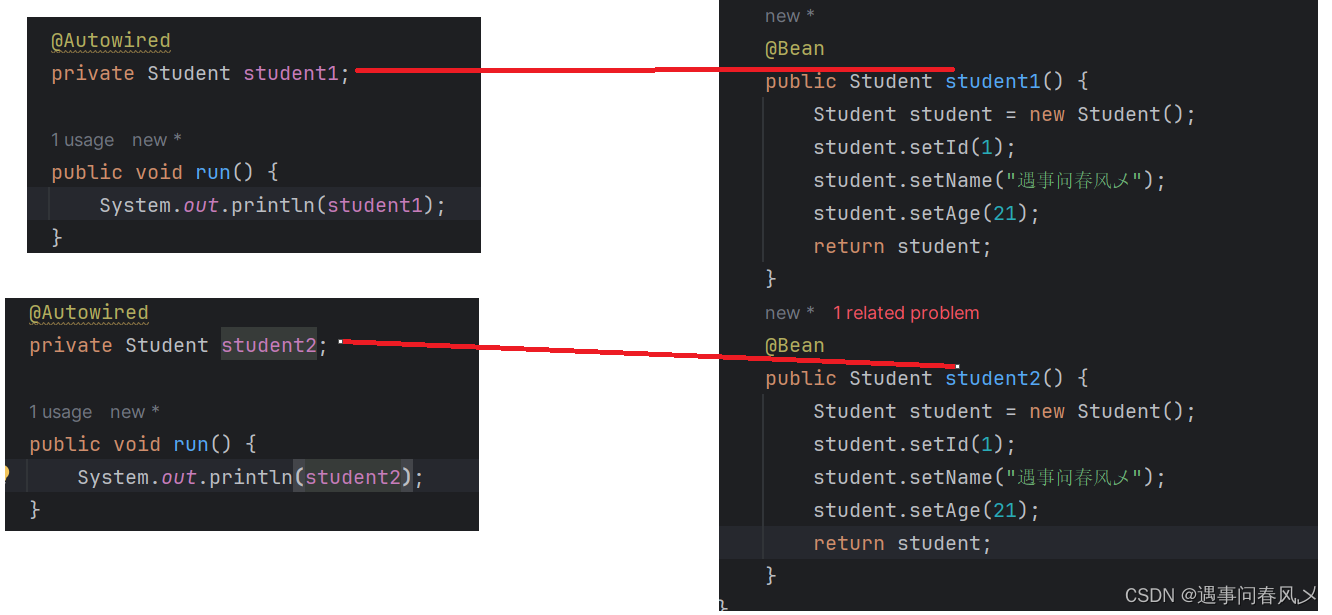
第二种:使?@Primary注解:当存在多个相同类型的Bean注?时,加上@Primary注解,来确定默认的实现.
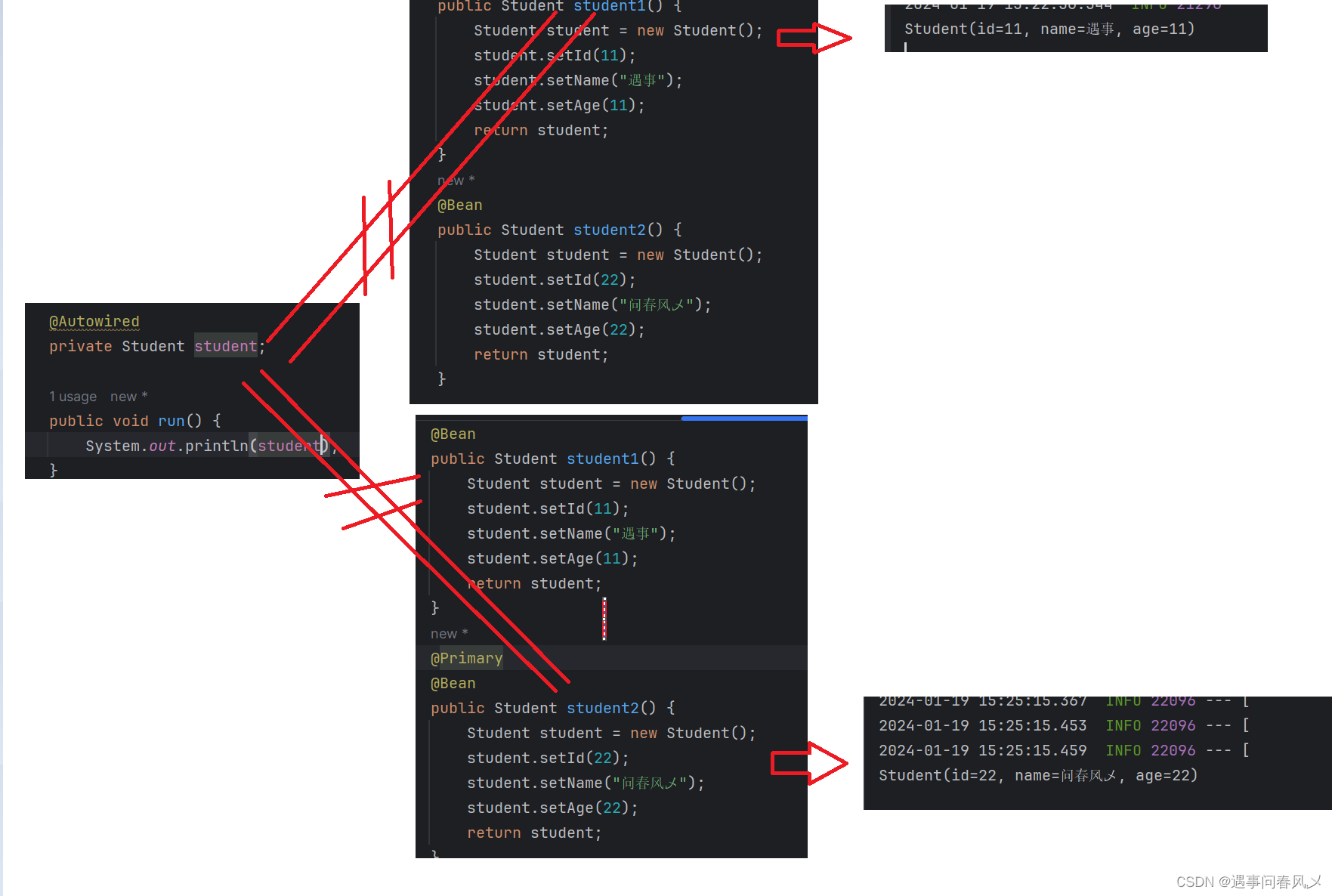
第三种:使?@Qualifier注解:指定当前要注?的bean对象。在@Qualifier的value属性中,指定注?的bean的名称。
- @Qualifier注解不能单独使?,必须配合@Autowired使?
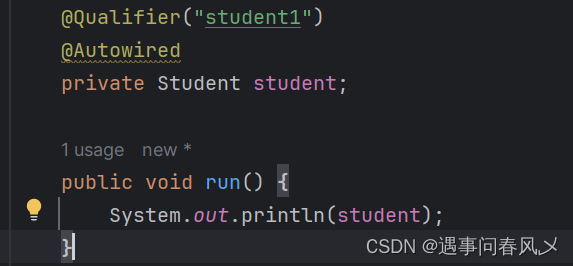

第四种:使?@Resource注解:是按照bean的名称进?注?。通过name属性指定要注?的bean的名称。
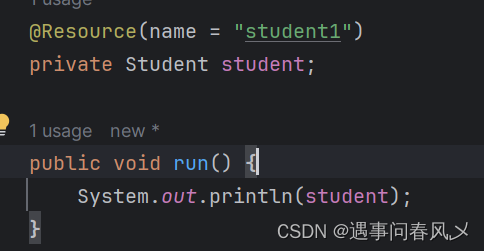

🍃@Autowird与@Resource的区别
-
@Autowired是spring框架提供的注解,?@Resource是JDK提供的注解
-
@Autowired默认是按照类型注?,?@Resource是按照名称注?.相?于@Autowired来说,@Resource?持更多的参数设置,例如:name设置,根据名称获取Bean。
?总结
关于《【JavaEE进阶】 依赖注?DI详解》就讲解到这儿,感谢大家的支持,欢迎各位留言交流以及批评指正,如果文章对您有帮助或者觉得作者写的还不错可以点一下关注,点赞,收藏支持一下!
本文来自互联网用户投稿,该文观点仅代表作者本人,不代表本站立场。本站仅提供信息存储空间服务,不拥有所有权,不承担相关法律责任。 如若内容造成侵权/违法违规/事实不符,请联系我的编程经验分享网邮箱:chenni525@qq.com进行投诉反馈,一经查实,立即删除!
- Python教程
- 深入理解 MySQL 中的 HAVING 关键字和聚合函数
- Qt之QChar编码(1)
- MyBatis入门基础篇
- 用Python脚本实现FFmpeg批量转换
- 如何在“Microsoft Visual Studio”中使用OpenCV构建应用程序
- Property ‘unmount‘ does not exist on type ‘Window & typeof globalThis‘
- 神经网络:机器学习基础
- 3ds max软件中的一些常用功能分享!
- 数据可视化(附带操作实例)
- 从0开始学前端第三天
- pytorch02:数据读取DataLoader与Dataset、数据预处理transform
- 超详细 | 哈里斯鹰优化算法原理、实现及其改进与利用(Matlab/Python)
- C语言运算符
- “AIGC大模型工程师和产品专家深度训练营”近屿智能OJAC带您走进AI新纪元